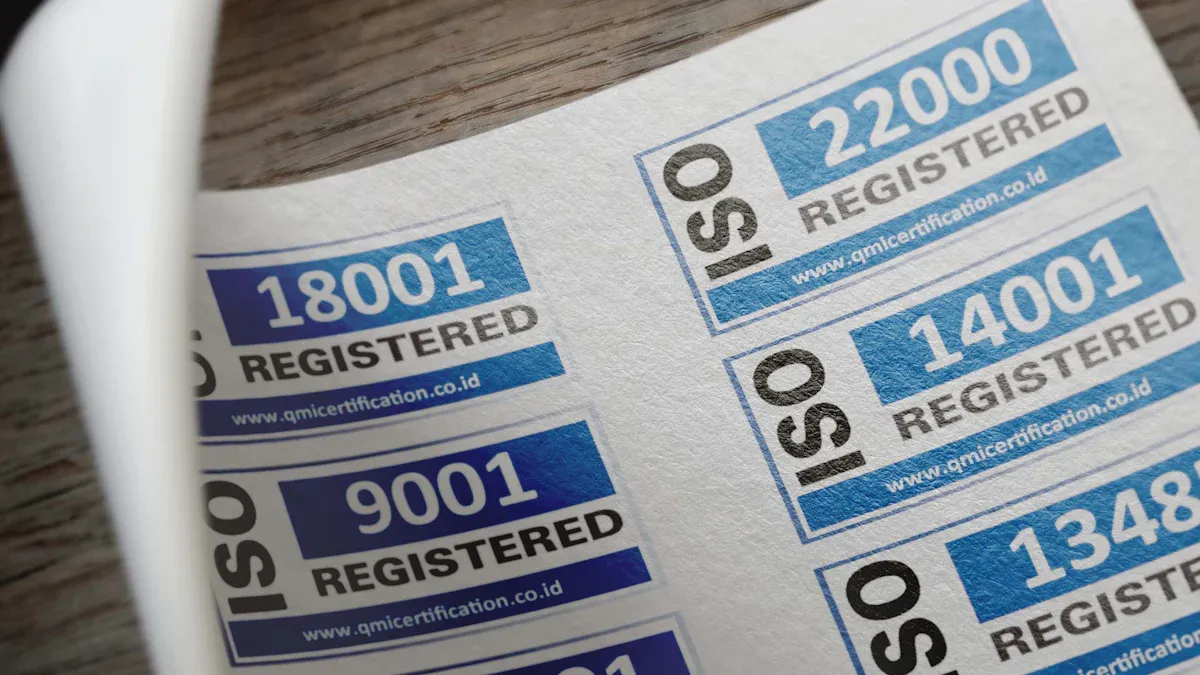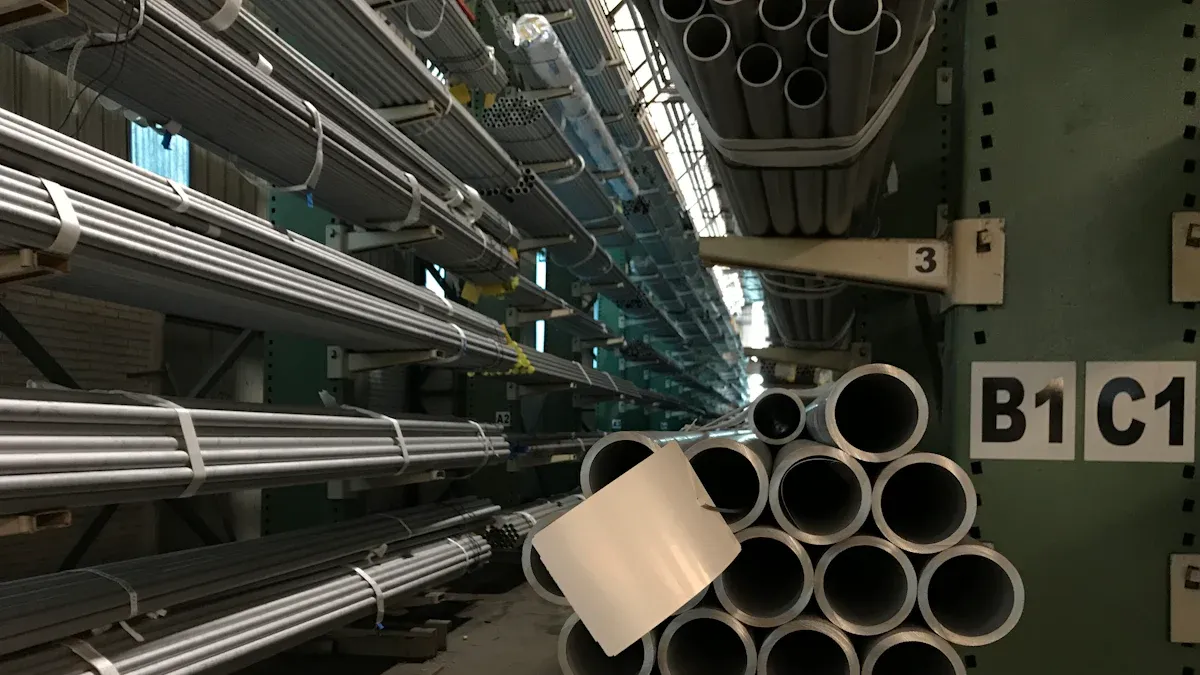What ISO 13485 Certification Means for Nitinol Tubing Manufacturers

ISO 13485 certification sets the gold standard for quality management in the medical device industry. For medical nitinol tubing manufacturers, this certification ensures that your products meet stringent safety and performance requirements. It also demonstrates your commitment to delivering consistent quality, which is critical in life-saving applications like cardiovascular stents and surgical instruments.
By becoming ISO 13485 certified Nitinol tubing manufacturers, you align with global regulatory expectations. This helps you build trust with healthcare providers and patients while paving the way for smoother market access. The certification doesn't just validate your processes; it also positions your business as a reliable partner in the medical field.
Key Takeaways
ISO 13485 certification shows nitinol tubing is safe and high-quality.
This certification helps companies follow rules and sell worldwide easily.
Using ISO 13485 quality systems lowers risks and makes products better.
Regular checks and updates keep the certification and product quality strong.
ISO certification builds trust by proving safety and quality to everyone.
Understanding ISO 13485 Certification

Purpose and Scope of ISO 13485
ISO 13485 certification plays a critical role in ensuring the safety and effectiveness of medical devices, including nitinol tubing. This standard focuses on establishing a robust quality management system (QMS) tailored to the unique needs of the medical industry. Unlike ISO 9001, ISO 13485 does not emphasize continual improvement. Instead, it prioritizes the effective implementation and maintenance of quality systems. This approach ensures that your processes consistently meet regulatory requirements and deliver reliable products.
The scope of ISO 13485 extends beyond manufacturing. It applies to all stages of a medical device's lifecycle, from design and development to production and post-market activities. For nitinol tubing manufacturers, this means adhering to strict guidelines that ensure product quality and patient safety. The standard also aligns with global regulations, such as the EU Medical Device Regulation (MDR) and the In Vitro Diagnostic Regulation (IVDR). By achieving ISO 13485 certification, you simplify compliance with international standards and reduce the risk of regulatory issues.
Evidence Description | Key Points |
|---|---|
Importance of ISO 13485 Certification | Ensures quality management, regulatory compliance, and patient safety in medical device production, including nitinol tubing. |
Role in Safety and Effectiveness | Serves as a global benchmark for quality management systems, focusing on the lifecycle needs of medical devices. |
Risk Management Benefits | Structured processes prevent safety issues and improve product reliability, enhancing user safety and effectiveness. |
Compliance with Standards | Ensures that nitinol tubing meets high quality and regulatory standards, minimizing risks in healthcare settings. |
Simplification of Global Compliance | Aligns with international standards, making it essential for manufacturers to meet global regulatory requirements. |
Key Requirements for Medical Device Manufacturers
To achieve ISO 13485 certification, you must meet several key requirements. These requirements ensure that your quality management system supports the production of safe and effective medical devices. The standard outlines specific clauses that address various aspects of your operations:
Clause | Key Requirements |
|---|---|
4 | General requirements for a QMS, including documentation and risk management procedures. |
5 | Management responsibilities to ensure adherence to quality policies and procedures. |
6 | Resource management to support compliance with ISO 13485. |
7 | Product realization processes from conceptualization to implementation. |
8 | Measurement, analysis, and improvement of product performance post-release. |
These requirements apply not only to manufacturers but also to suppliers, service providers, and quality management organizations working within the medical device industry. For nitinol tubing manufacturers, adhering to these guidelines ensures that your products meet the highest standards of quality and reliability. By implementing structured processes, you can minimize risks, improve product consistency, and enhance your reputation in the medical field.
Why ISO 13485 Certification Matters for Nitinol Tubing Manufacturers
Ensuring quality and reliability in medical nitinol tubing
ISO 13485 certification plays a vital role in ensuring the quality and reliability of medical nitinol tubing. As a manufacturer, you must meet stringent standards to produce tubing that performs consistently in critical medical applications. These applications often involve life-saving devices like stents and catheters, where even minor defects can lead to significant risks. By adhering to ISO standards, you demonstrate your commitment to delivering products that meet the highest levels of safety and quality.
Certified manufacturers implement robust quality management systems that focus on minimizing risks and enhancing patient safety. These systems help you identify potential issues early in the production process, reducing the likelihood of defects. For example, ISO-certified tubing undergoes rigorous testing to ensure it meets precise specifications for flexibility, durability, and biocompatibility. This attention to detail ensures that your medical nitinol tubing performs reliably in demanding environments.
Choosing certified manufacturers is essential for healthcare providers and device companies. It reduces the risks of using non-certified manufacturers, which may produce tubing that fails to meet regulatory requirements or safety standards. Partnering with certified suppliers also strengthens your reputation as a trusted provider of high-quality medical components.
Tip: Enhancing patient safety starts with ensuring product quality. ISO 13485 certification provides the framework you need to achieve this goal.
Supporting regulatory compliance in global markets
ISO 13485 certification simplifies compliance with regulatory requirements in global markets. As a nitinol tubing manufacturer, you must navigate complex regulations that vary by region. For instance, the European Union's Medical Device Regulation (MDR) and the U.S. Food and Drug Administration (FDA) have strict guidelines for medical device components. ISO certification aligns your processes with these regulations, making it easier to gain market approval.
Certified manufacturers benefit from streamlined documentation and audit processes. Regulatory bodies often recognize ISO-certified tubing as meeting essential safety and quality standards. This recognition reduces the time and effort required to demonstrate compliance during inspections. It also minimizes the risk of delays or rejections when entering new markets.
By achieving ISO 13485 certification, you position your business as a global leader in the medical industry. This certification not only supports compliance but also enhances your credibility with international customers. It shows that your products meet the rigorous standards required for medical applications, giving you a competitive edge in the marketplace.
Note: The certification process may seem challenging, but the long-term benefits far outweigh the initial effort. ISO 13485 certification opens doors to new opportunities and strengthens your position in the global market.
Benefits of ISO 13485 Certification

Operational improvements for iso 13485 certified nitinol tubing manufacturers
ISO 13485 certification drives significant operational improvements for nitinol tubing manufacturers. By implementing the rigorous standards outlined in the certification, you can streamline your processes and enhance overall efficiency. This certification ensures that your production methods align with global best practices, reducing errors and improving product quality.
Certified manufacturers often report measurable performance gains. For example, adhering to quality management systems ensures consistent reliability in your operations. Meeting FDA standards further demonstrates your commitment to regulatory compliance, which builds trust in your processes. Additionally, the ability to customize nitinol tubing to meet specific medical requirements highlights your focus on continuous improvement. The table below summarizes these key metrics:
Metric Type | Description |
|---|---|
Quality Management Systems | ISO 13485 certification ensures adherence to quality standards, indicating improved reliability. |
Compliance | Meeting FDA standards serves as a benchmark for regulatory adherence, enhancing process trust. |
Customization Capabilities | Tailored nitinol tubing to specific requirements indicates a focus on process improvement. |
These operational enhancements not only improve your internal workflows but also lead to better outcomes for your customers. By reducing variability and ensuring consistent product quality, you can meet the high expectations of the medical industry. This focus on precision and reliability positions you as a leader in the field of medical nitinol tubing manufacturing.
Tip: Regularly reviewing your processes under ISO 13485 guidelines can help you identify areas for further improvement, keeping your operations competitive and efficient.
Building customer trust and enhancing market access
ISO 13485 certification plays a pivotal role in building trust with your customers. In the medical industry, trust is essential. Healthcare providers and device manufacturers need assurance that the components they use meet the highest safety and quality standards. By achieving certification, you demonstrate your commitment to delivering reliable and safe products.
Certified manufacturers gain a competitive edge by showcasing their adherence to stringent regulatory requirements. This certification signals to your customers that your nitinol tubing meets global standards for safety and performance. It also simplifies the approval process for your products in international markets. Regulatory bodies often recognize ISO-certified tubing as compliant with essential safety and quality benchmarks, reducing the time and effort required for market entry.
Market access becomes significantly easier when you hold ISO 13485 certification. Many regions, including the European Union and the United States, have strict regulatory frameworks for medical devices. Certification ensures that your products align with these frameworks, minimizing delays and potential rejections. This streamlined compliance process allows you to expand your reach and serve a broader customer base.
Note: Building customer trust is not just about meeting standards; it’s about exceeding expectations. ISO 13485 certification helps you achieve this by ensuring your products consistently deliver on quality and safety.
The benefits of ISO 13485 certification extend beyond operational improvements. They position you as a trusted partner in the medical industry, opening doors to new opportunities and strengthening your reputation in the global market.
The Certification Process for Nitinol Tubing Manufacturers
Steps to achieve ISO 13485 certification
Achieving ISO 13485 certification involves a structured approach. You need to start by understanding the requirements of the standard and assessing your current processes. Conduct a gap analysis to identify areas where your operations fall short of compliance. This step helps you pinpoint the changes needed to align with ISO standards.
Next, develop and implement a robust quality management system tailored to your manufacturing processes. Focus on areas like risk management, documentation, and product realization. Ensure your system addresses the unique challenges faced by nitinol tubing manufacturers, such as maintaining product quality and meeting regulatory requirements.
Training your team is essential. Educate employees on ISO 13485 principles and their role in maintaining compliance. This ensures everyone understands the importance of safety and quality in medical device manufacturing. Once your system is in place, conduct internal audits to verify its effectiveness. These audits help you identify and resolve issues before the certification audit.
Finally, schedule an audit with a certification body. During this audit, certified manufacturers must demonstrate their adherence to ISO 13485 standards. If successful, you’ll receive your certification, positioning your business as a trusted provider of medical nitinol tubing.
Tip: Start with small, manageable changes to your processes. Gradual improvements make the certification journey less overwhelming.
Preparing for audits and maintaining compliance
Preparation is key to passing ISO 13485 audits. Begin by organizing your documentation. Ensure all records, including quality management systems, risk assessments, and product specifications, are up-to-date and easily accessible. Auditors will review these documents to confirm your compliance with ISO standards.
Conduct mock audits to simulate the certification process. These practice sessions help you identify gaps and prepare your team for the actual audit. Address any issues uncovered during the mock audit to strengthen your compliance efforts.
Maintaining compliance requires ongoing effort. Regularly review and update your processes to reflect changes in regulatory requirements. Monitor your operations to ensure they consistently meet ISO 13485 standards. Encourage your team to report potential issues promptly, allowing you to address them before they escalate.
Certified manufacturers must also stay informed about updates to ISO standards and medical regulations. This proactive approach ensures your nitinol tubing continues to meet global safety and quality benchmarks. By prioritizing compliance, you protect your reputation and maintain customer trust.
Note: Compliance isn’t a one-time achievement. Treat it as a continuous process to ensure long-term success.
Overcoming Challenges in Certification
Addressing common obstacles
Navigating the path to ISO 13485 certification can be challenging for nitinol tubing manufacturers. Several obstacles often arise, impacting timelines and operational efficiency. Understanding these challenges helps you prepare better and avoid costly delays.
One significant hurdle involves sourcing raw materials. Over 70% of global nickel production, a key component of nitinol, comes from regions prone to geopolitical instability. This dependency can disrupt supply chains and delay production. Additionally, precision manufacturing requirements pose another challenge. With fewer than 15 global suppliers capable of producing medical-grade nitinol tubes, you may face limited options and higher costs.
Regulatory compliance also adds complexity. For instance, audits can delay shipments by 6–12 months, as seen in a case where a 14-month delay in CE Mark recertification disrupted deliveries. Logistics and storage constraints further complicate matters. Climate-controlled packaging increases shipping costs by 20–30%, while global port congestion has extended lead times from 8 weeks to over 5 months in some regions. Intellectual property barriers, such as monopolistic pricing by a single supplier controlling 40% of the laser-cut nitinol tube market, create additional challenges.
Obstacle Type | Description |
|---|---|
Raw Material Sourcing Challenges | Over 70% of global nickel production is concentrated in regions prone to geopolitical instability, affecting material availability. |
Precision Manufacturing Requirements | Fewer than 15 global suppliers can produce medical-grade Nitinol tubes, creating dependency risks. |
Regulatory Compliance Issues | Regulatory audits can delay shipments by 6–12 months, with a specific example of a 14-month delay in CE Mark recertification disrupting deliveries. |
Logistics and Storage Constraints | Shipping costs increase by 20–30% due to climate-controlled packaging needs, and lead times have extended from 8 weeks to over 5 months in some regions due to global port congestion. |
Intellectual Property Barriers | A single supplier controls 40% of the laser-cut Nitinol tube market, leading to monopolistic pricing and limited supplier diversification. |
Strategies for successful implementation
Overcoming these challenges requires a proactive approach. Start by diversifying your supply chain to reduce dependency on a single region or supplier. Establish relationships with multiple vendors to ensure a steady flow of raw materials. For precision manufacturing, invest in advanced technologies and collaborate with trusted partners to meet medical-grade standards.
Regulatory compliance demands meticulous planning. Align your processes with ISO 13485 certification requirements early in the development phase. For example, ensure your nitinol tubing meets ASTM F2063 standards and complies with ISO 10993-1 for biocompatibility testing. These steps minimize the risk of product recalls or legal penalties.
To address logistics issues, optimize your packaging and shipping strategies. Partner with logistics providers experienced in handling medical devices. This reduces delays and ensures the safety of your products during transit. Intellectual property barriers can be mitigated by exploring alternative suppliers or investing in in-house capabilities to reduce reliance on monopolistic markets.
Tip: Regularly review your quality management system to adapt to evolving regulatory requirements. Staying informed about global standards ensures smoother certification and market entry.
By implementing these strategies, you can navigate the complexities of ISO certification more effectively. This positions your business as a reliable provider of high-quality medical nitinol tubing.
ISO 13485 certification is essential for nitinol tubing manufacturers aiming to thrive in the competitive medical device industry. It ensures your products meet global quality standards, fostering trust with healthcare providers and patients. Long-term benefits include operational growth and market expansion. For example, SAES Group leveraged their certification to meet a 30% annual demand increase for orthodontic archwires. Similarly, Confluent Medical Technologies maintains FDA-compliant cleanrooms, ensuring consistent quality. By pursuing certification, you position your business as a reliable partner in the medical field and secure a competitive edge in global markets.
FAQ
What is ISO 13485 certification, and why is it important for nitinol tubing manufacturers?
ISO 13485 certification ensures your manufacturing processes meet international quality standards for medical devices. It demonstrates your commitment to safety and reliability, which is crucial for producing nitinol tubing used in life-saving applications like stents and catheters.
How does ISO 13485 certification help in supporting global market access?
This certification aligns your processes with international regulations, simplifying compliance in regions like the EU and the U.S. It reduces delays during audits and approvals, making it easier for you to enter and compete in global markets.
What are the key steps to maintain ISO 13485 compliance?
You should regularly review your quality management system, update documentation, and conduct internal audits. Training your team on regulatory updates and addressing issues promptly ensures your operations remain compliant with ISO 13485 standards.
How long does it take to achieve ISO 13485 certification?
The timeline varies based on your current processes. On average, it takes 6-12 months to complete the gap analysis, implement a quality management system, and pass the certification audit.
Can small manufacturers afford ISO 13485 certification?
Yes, small manufacturers can achieve certification by starting with incremental improvements. Focus on critical areas like risk management and documentation. Partnering with consultants or certification bodies can also streamline the process and reduce costs.
See Also
The Process Behind Manufacturing Nitinol Tubing for Healthcare
Nitinol Tubing's Impact on the Future of Medical Devices
The Importance of Nitinol Tubing in Modern Medical Uses
Investigating Nitinol Tubing Uses in Healthcare Technology
Nitinol Tubing's Contribution to the Advancement of Medical Tech

